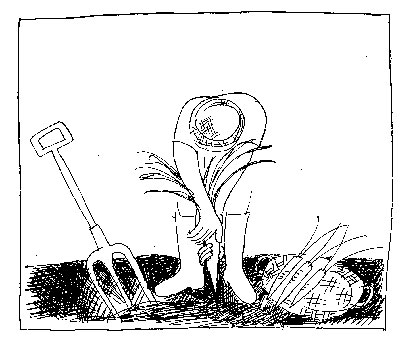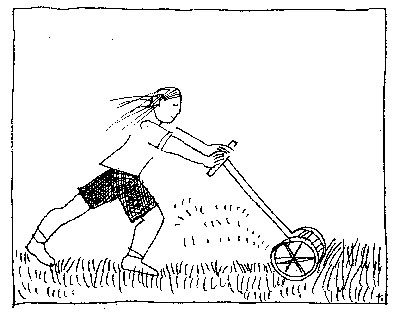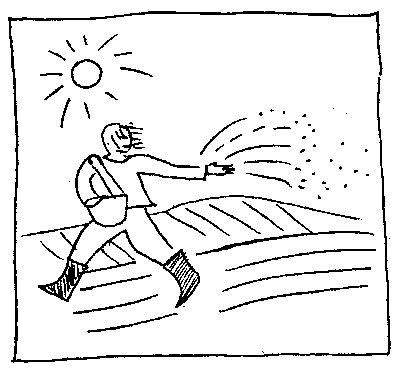 |
| Toki Oshima drawings |
By Sue Smith-Heavenrich
Regular yard work can help prevent osteoporosis, says Dr. Lori Turner from the University of Arkansas. She and her team of researchers have found that women aged 50 and older who garden at least once a week have stronger bones than their peers. Digging holes, pulling weeds, pushing a mower, moving buckets and bags of compost – all of these provide opportunities to strengthen muscles and bones. And women who garden regularly have higher bone density than women who jog, swim or walk.
For many years scientists have been advising older women to participate in weight-bearing exercises to keep their bones strong. Dr. Turner wondered which weight-bearing exercises were the best, so she studied over 3,000 women aged 50 or more. “More than half the women – 57 percent – showed low bone density,” writes Turner. Osteoporosis is a problem, among older people, affecting both men and women. And while health professionals have been looking at ways of treating it, Dr. Turner believes that the focus ought to be on prevention. She wondered if exercise might help.
Turner compared how often older women participated in different activities. Did they do yard work, bicycle, dance, walk, swim … take up weight training? Turner compared each activity to bone mass. When she analyzed the data she discovered that only two activities stood out as helping maintain healthy bone mass – yard work and weight training.
“Gardening is often taken for such a dainty activity,” says Dr. Turner. “But there’s a lot of weight-bearing motion going on in the garden.” And those weight-bearing activities are important for keeping bones strong, because they force bones and muscles to work against gravity.
 |
In addition, because gardening is an outdoor activity, the exposure to sunlight boosts vitamin D production. That aids the body in absorbing calcium, a mineral necessary for strong bones.
Weight training would do the same thing, but it’s not as much fun as gardening. Gardening is something women like to do, says Turner. And if they’re doing something they like, they’ll stick with the activity. “I get a lot of enjoyment out of the work,” says Gwen, my 50-something-year-old gardening friend who’s been tilling up a patch of earth for nearly half a century. She learned how to make cuttings and propagate plants from slips by watching her grandmother. Now her own gardens of grains, flowers and vegetables cover about 4 acres around her home.
“Of course, I don’t till and weed every single bit,” Gwen admits. For many years a neighboring dairy farmer has helped with the plowing and disking. Then Gwen, who follows the advice from Ruth Stout and gardens the lazy way, covers as much of the ground as she can with mulch.
“First I broadcast about 1,000 pounds of seeds – grains and sunflowers mixed together. I plant things around the house too, dig bulbs and re-plant them to spread them around. There’s raking and harvesting to do as well. But not much weeding; the mulch takes care of that.”
For Gwen, gardening isn’t work, even if it involves sowing 1,000 pounds of seeds. It’s an opportunity to relax from the stresses of her work. She runs a family-style assisted living facility, usually caring for half a dozen residents at any time. In the garden, Gwen paces herself, allowing time to listen to the birds, admire the fragile beauty of a wildflower. Broadcasting the seeds is part of that. She meanders around the back and side of her small vegetable and flower gardens, flinging the seeds in graceful arcs. It’s like dancing, almost. And, she points out to me, it’s a great “range of motion” exercise. This is a wild garden of grains, sunflowers and wildflowers that Gwen grows for birds and insects. About the only maintenance she does in these gardens is to mow paths, or thin around specific plants she’d like to encourage to grow. Because of the nature of her business, she needs to go into the house frequently – to set the table for a meal, check what’s on the stove, help someone move into the sunny community room where there’s a card table with puzzles. In the spring, that card table is covered with flats, potting soil, seed packets. Later she’ll return to the garden for some sunshine, relaxation, and a bit of exercise.
 |
“I’ve learned to adapt my activities to my age,” Gwen points out. “I no longer carry 50-pound bags over my shoulder. Now I haul them around with the lawn tractor, or in a wheelbarrow.” She’s also learned to work with nature. Rather than pulling out weeds, she cuts them, allows them to dry and uses them as mulch. “They conserve water in the beds, and keep new weeds from growing!”
Pat, also a 50-something gardening friend, is a member of the local Garden Club and edits its monthly newsletter. She has had to learn how to accommodate her creaky joints by changing the gardening landscape around her home. “My gardens are smaller these days,” she notes, “planted on raised beds so they’re easier to reach.” She’s planted her herbs in tall flowerpots and put them near the porch where she can sit on a stool to tend them – reducing stress on her knees.
“I was born and raised in a garden,” Pat claims. “Sure I do less now, and I buy lots of produce at the local farmstand, but we’re still raising rhubarb, tomatoes. This year I’m going wild – growing lots of different pepper varieties.” She’ll turn the habaneros into jellies that she sells at the farmer’s market next town over.
“I’ve slowed down some,” Pat admits. “I’ll shovel on a bit of mulch, then take a rest. I can do most of everything … just less than I used to. Still,” she winks, “I have plans to put in a few fruit trees and raspberry bushes.”
Getting people to stick to an exercise routine is tough, but gardeners willingly move heavy things, push and pull, bend and stretch. The fact that gardeners enjoy doing the work makes garden and yard work effective in helping to prevent osteoporosis. “Gardening makes you feel healthier too,” says Gwen. “I feel better mentally, physically, emotionally and spiritually when I garden. Sometimes it’s a very meditative experience.” Perhaps this is why some of her senior residents participate in the gardening activities going on around them. At the age of 99, one of her seniors was involved in starting seeds, watering the plants in window boxes, and walking along the paths to gather flowers. “We make adjustments,” Gwen points out, “like using a plastic quart measuring cup instead of a watering can.” And the paths are wide enough for walkers and are graded and graveled.
Sure, we might slow down a bit as we age, but one thing’s clear: Taking the time to smell the roses – and prune them, water them and weed around them – is as good for the body as it is for the soul.
